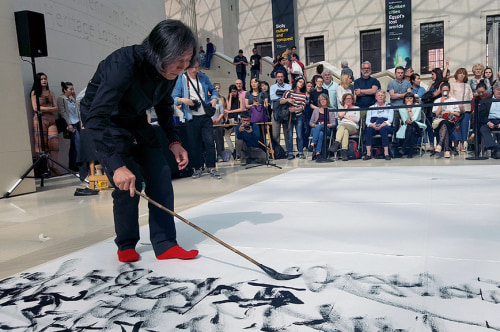
FOR THIS YEAR’S London Craft Week, one of the clear highlights was a live performance by Wang Dongling, perhaps the greatest, or at least most famous, living Chinese calligrapher. Having caught about half an hour of sleep after the opening of my own exhibition of calligraphic works at Exile in Berlin, I hopped on an early morning flight to the city on the Thames to see the master’s first public performance in London in more than twenty years.
Wang is a professor of calligraphy at the Fine Art Academy in Hangzhou and one of the foremost contemporary practitioners of the ancient art. His style is essentially a fusion of cursive script with the whole-body movements of Abstract Expressionism—at times his work is reminiscent of early Pollocks or Klines. His art is often characterized as illegible, or “asemic.” The term asemic is problematic, in that it implies a writing that is empty of meaning. Rather, it is Wang’s task—and the task of advanced calligraphy, arguably—to explore and posit new forms of writing that thus necessitate new ways of reading and interpreting. This is rooted in the primacy of gesture, the body; while the text—often an ancient one, such as a poem by a Tang Dynasty master or else from a philosophical treatise by Lao Tzu or Chuang Tzu—is present in the work, its legibility assumes secondary importance to its corporeal manifestation on the paper.
As I arrived at the main hall of the British Museum, Wang’s assistants were at work preparing for the performance, taping to the floor four sheets, each about six feet in length. A few rows of chairs formed a semicircle around the roped-off area. They quickly filled up with an array of fans, London Craft Week staff, PR people, and random tourists lucky enough to be visiting the British Museum at this hour.
“Usually I don’t give speeches beforehand because I need time to meditate, but I wanted to apologize and explain that today we need some extra time for preparation,” Wang told us in Mandarin, conveyed in English via an interpreter. After a few more minutes and a slightly Orientalizing introductory speech by someone from London Craft Week (in which the audience was encouraged to watch the master calligrapher “go into a meditative state” in preparation for the performance; FYI, he did nothing of the sort), Wang lifted his long bamboo brush and began.
His text-painting would be a graphic exegesis of the Heart Sutra, one of the canonical texts of Mahayana Buddhism. In Chinese, the text consists of 268 characters. Wang worked with a studied intensity, from right to left, up to down, the traditional way in Chinese calligraphic practice. Carbon-based ink is viscous stuff that can be applied heavily, with a resonance approaching near violence in its propensity to shine, or lightly, revealing the materiality of the brushstrokes—two very different graphic effects. Wang is perpetually associated with the former, which is why I was surprised to see a very light application of ink today, giving the overall work—performance and calligraphic text alike—a feeling of tentativeness. Maybe it was all of the cameras—everyone present at least had their phone out; at times, when he clearly felt the presence of a nearby photographer focusing on his face while he was at work, Wang would bark out a request for them to stop.
Beside the simple desire to see a master calligrapher at work, there was a second curiosity behind my decision to watch Wang’s performance, a curiosity as to the how and why behind the artist’s exhibitionistic gesture. I happen to have a certain terror of anyone watching me while I’m writing, and particularly writing by hand. I’m not alone. According to legend, it is what killed Pollock; he had given up drinking for years, only to return to it with force immediately after allowing himself to be filmed by a television crew at work in his studio. Wang’s performances seem to imply an attack on the hermeticism of the form, yet the clear signs of his own reticence imply an irresolution. Then again, in light of the obsolescence of calligraphic practices and handwriting in general, there is almost an activistic stance to the gesture.
As we move further away from technologies of writing deemed primitive, there seems to be a renewed interest in them. One need only point to sources as disparate as asemic writing, Hans Ulrich Obrist’s Instagram dedicated exclusively to handwriting, the écriture of Dansaekhwa painter Park Seobo, and Cy Twombly’s lifelong exploration of the archeology of the scrawl to contextualize the fascination with which we arrive at Wang Dongling’s practice of writing in situ.
The completed work, an anthology of sigils and slashes, loosely connected in some sort of mad cursive otherworldly script, was left behind to dry beneath the bright rays trespassing the British Museum’s enormous glass-domed roof. The artist hardly lingered, disappearing into the crowd moments after putting down his brush.